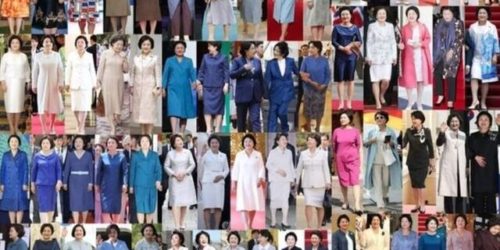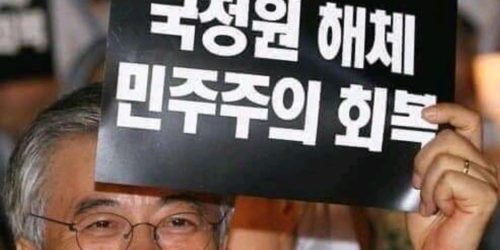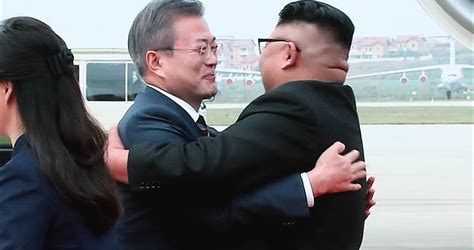Why does North Korea’s Apology Letter Have South Korean Spellings and Style, and Why was the Letter Changed?
2020-9-26, Tara O
On September 22, 2020, a South Korean citizen was shot and burned by North Korea at sea. He was a 47-year old South Korean government employee under the Ministry of Oceans and Fisheries, who disappeared the day before near Yeonpyeong Island. Early morning the next day on September 23, 2020, South Korean president Moon went ahead and gave a speech to the UN calling for the “end of war declaration” with North Korea. Moon did not mention the man killed and burnt by North Korea and did not give any instructions to take measures to save the South Korean citizen’s life, despite receiving the situation report about him on September 22 at 6:36 p.m. North Korea apparently sent an “apology letter,” and the Blue House officials and the ruling party lawmakers hailed this move and praised Kim Jong-un. Meanwhile, the South Korean public is horrified that their own government is not concerned that its own citizen was killed and that it did not make any effort to protect the man, but instead is praising Kim Jong-un. The below is a timeline, followed by the extensive changes (47 changes and additions) to the apology letter that raise questions about the authenticity of the apology letter.
9/21/2020:
11:30 a.m: A 47-year old employee of the Ministry of Oceans and Fisheries missing from the Fishery Patrol Ship near Small Yeonpyeong Island.
9/22/2020:
3:30 p.m. The missing man emerged near Deungsan-got, Hwanghae Province, according to the South Korea Ministry of National Defense; the exhausted man is still in the water holding on to a flotation device. He was not taken out of the water.
9:40 p.m. North Korea shoots the man in the water 10 times and kills him.
10:11 p.m. North Korea douses him with oil and burns his body at sea.
The Apology Letter
North Korea hardly ever apologizes for any of its atrocities. Thus, the apology letter was a surprise, and the focus seemed to have shifted from the man’s death to the unusualness of an apology from North Korea. However, questions arise, because the letter’s content displayed on the Blue House website changed from one day (9/25/2020) to the next (9/26/2020) quite extensively. It was explained on Lee Jeong-hoon TV (이정훈TV). Lee is a veteran journalist.
There are seven screenshots comparing the content from September 25 and September 26, 2022. Not all the changes will be pointed out, but the reader should be able to see visually what characters were added and changed, and how many there are.
Red characters: additions
White bold characters: changes
In Screen 1, the characters in red were added on September 26. The white bold letters were changed. For instance, “영해” (yeonghae) means territorial waters, but it is a South Korean spelling. North Korea uses “ㄹ” instead of “ㅇ,” so the North Korean spelling is “령해” (ryeonghae). Thus, the version on the 25th used a South Korean term. Another change is “했다” was changed to “하였습니다,” which is a more polite form of ending a sentence.
There are numerous changes and additions here too. “80미터” (80 meters pronounced mee-tuh) was changed to “80m.” According to Dr. Lee Ae-ran, a defector from North Korea, North Korea does not use “미터,” but rather “메터” (meh-tuh), with a different pronunciation for meter. The changed version did not use 메터, but “m,” which is English abbreviation for meter.
The version posted on September 25 begins “(The man) remained silent and did not comply with our side soldiers’s enforcement orders, so (the soldiers) shot two blank shots. Surprised, he laid face down, creating an atmosphere in which he cannot be identified. According to some of the soldiers’ testimonies, the soldiers said (he) appeared to behave as if to try to cover himself with something as he laid face down.”
The version on the 26th added more words to make the sentences flow smoother, but it also added additional adjectives, such as “continuously” in front of noncompliance. It also changed “두발” (doobal) to “2발” (doobal, but changed the number from phonetic to an Arabic number) and “공포” (gongpo) to “공탄” (gongtan). They both mean blanks, but gongpo is a South Korean word and gongtan is a North Korean word. In the latter version, the last sentence reads “According to some of the soldiers’ testimonies, the soldiers said they saw that (he) appeared to behave as if to try to cover himself with something as he laid face down.”
“했..” is changed to “하였..,” which is North Korean style of writing. It’s a verb that means “to do.” This change was seen elsewhere.
There are more changes here, including replacing “이해” (i-hae) with “리해’ (ri-hae), which means “understanding.” In general, words were added or changed to make the sentences flow smoother, make them more polite, and make them sound more “North Korean.”
The Workers’ Party of Korea is spelled the South Korean way–노동당 (nodongdang)–on the 25th, but it was changed to North Korean spelling–로동당 (rodongdang)–on the 26th. The way the dates are shown is changed too. Interestingly, it does not have the Juche date.
Question
North Korea has not mentioned the apology letter in its official state media. Park Jie-won, the controversial new director of the National Intelligence Service (NIS), was the one who “hand-carried the apology letter received from the North side to the Blue House” on the morning of September 25, 2020 and Suh Hoon, the National Security Adviser, gave two briefings based on the “apology letter.” Moon Jae-in instructed Suh to make the letter public, and Suh made it public at 2 p.m. on the same day.
If North Korea indeed sent the apology letter, then why was it mixed with South Korean spellings and style on the version displayed on September 25? Why was it changed to a more polite way of expressing sentences? Why were there so many changes–at least 17 additions and 30 changes, and so quickly? With so many changes, typos cannot be an excuse. Was it really North Korea that created the letter or someone in South Korea?






1 Response